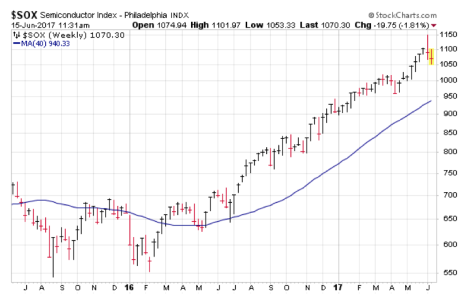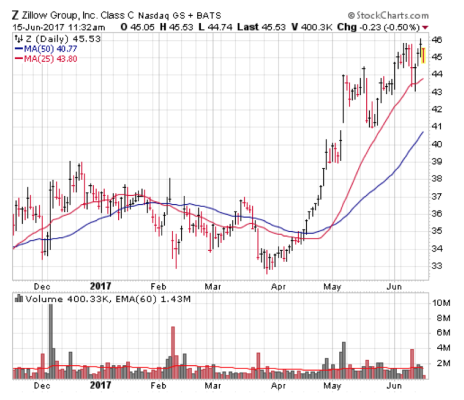Despite a solid advance for the overall market and a powerful advance in many growth stocks, my subscribers have been relatively quiet—I’ve been answering maybe three or four emails per day plus a phone call or two. Nothing big. But since last Friday, when the leading growth stocks came under a wave of distribution, my email volume has picked up to 15 to 20 per day, with another three or four phone calls. People have woken up! And their questions range from individual stocks to the market to chart questions to the big picture about what the growth stock selloff means.
So today, I’ll run through a quick view of my thoughts (in a Q&A format) about what I’ve seen during the past week, what I’m looking for, and the short- and long-term picture. Let’s get to it.
Is the recent growth stock selloff a market top?
So, first and foremost, one of my bigger convictions is that this remains an overall bull market, partly based on the long-term charts (the market’s major trends are up and last November’s blastoff kicked the indexes out of 15-month ranges) and partly based on some long-term indicators like my 7.5% Rule. It’s also a plus that the NYSE Advance-Decline Line, which usually tops out months ahead of a bear market, hit a new high last week.

Learn More

Learn More

Learn More

Learn More
That said, the next few days will probably tell us whether what we’ve seen is more of a short-term (one to three weeks) situation, or whether growth stocks have reached an intermediate-term top and need to build new launching pads in the weeks and months to come.
What about the recent divergences you’ve been writing about—don’t those usually happen at major tops?
They can, but I’ve found divergences to be more of a “heads up” that there’s risk out there. Risk of what? Risk of either an overall market correction, or vicious rotation out of hot stocks and into some other areas that have been sitting around.
The latter is basically what we’ve seen in recent days, as financial stocks and the lagging small- and mid-cap indexes have shown a little strength, even as leading growth stocks fall.
But to answer the question, divergences between indexes in and of themselves are not a bear market signal.
Should we buy some of those newly strong groups like financials?
Well, my answer here is going to be a maybe. There are a few financial stocks that have already reached into new high territory—one made it into my Cabot Top Ten Trader this week, and I would expect more opportunities in the weeks ahead.
However, just because volatility in the market picks up doesn’t mean you should react to every daily move—i.e., just because financial stocks (or cyclical stocks) perk up for two or three days doesn’t necessarily mean you should shift your portfolio in that direction.
Remember, it takes time for big, institutional investors to position their portfolios, which is what creates trends in the market. So you don’t have to jump on every market wiggle, many of which prove to be fakeouts.
That’s not to say you shouldn’t keep your eyes open. Mine are! But if there are going to be major buy points in some non-growth sectors, they’ll emerge over the next couple of weeks, not all at once.
Back to the growth stock selloff. Should I be selling too? Buying? Holding?
If you’ve been following our advice and have been heavily invested, then I think some trimming makes sense; we have seen some abnormal action after a big run, which often leads to some further weakness. Thus, if you have some stocks that have broken down (say, though their 50-day moving averages), you could sell. And you can consider taking a partial profit or two in some bigger winners, maybe selling one-third of your shares and see what happens from here.
That said, I would remain mostly bullish and give most of your stocks a chance to hold up.
You didn’t mention anything about buying. Are you saying we shouldn’t buy?
Well, if you’re already heavily/fully invested, then I wouldn’t push the envelope on the buy side here—I would mostly focus on managing the stocks in your portfolio.
But notice I said “mostly.” I’m not against a little buying here, but I would tend to go for smaller-than-normal positions, whether you’re buying a growth stock that’s dipped toward support, or something else (financial stock, etc.) that’s possibly emerging. Start small, maybe purchasing half or two-thirds of what you’d normally buy (dollar-wise), and then consider averaging up if the stock heads higher.
How can I tell which winners I should take partial profits in?
This takes a little chart knowhow (or just a good memory of your stock), but generally speaking, it’s probably better to book a little profit on a stock that’s been running higher for many months (and thus is later in its advance, in theory), compared to something that, say, gapped up on earnings just three or four weeks ago.
For example, look at the weekly chart of the Philadelphia Semiconductor Index. It hit a low after Brexit last June of 644, and pretty much motored straight up to 1,150 last week—a year-long move of 78% without any major correction. I’m a bit wary of most chip stocks here, though of course, not every chip stock follows the sector’s index to a T.
Conversely, look at a stock like PayPal (PYPL)—it built a 21-month post-IPO base, broke out in late April and motored higher for a few weeks. All else equal, PYPL is probably early on in its overall advance, assuming the bull market continues (which I expect).
Thus, taking some chips off the table with later-stage stocks and sectors makes sense.
What about the short side—are you looking at any inverse exchange traded funds, maybe like one that targets chip stocks?
Unless you’re a swing trader, I’d be careful with the short side for one reason: Tops take time. So even a group like chips is still in a long-term uptrend and, worst-case scenario, is just beginning some major topping process now. And I’m not even going that far—I’m simply saying the group could be tired after a big run, and we’ll see how it goes.
Simply put, it’s still a bull market, and while I make no predictions and adjust my stance based on the market’s evidence, I’m still overall bullish.
What evidence are you looking for that would cause you to take action, either market-wise or with individual stocks?
Market-wise, like I said, I think the next few days will be important—the longer this growth stock selloff goes, the greater the chance that this is a shorter-term wobble that will resolve itself to the upside.
As for stocks, it’s the usual—I’m looking for resilience. In fact, the silver lining of a market shakeout/pullback is that you can usually see which stocks institutions are hesitant to get rid of (because they think higher prices are coming). When you combine a reasonable pullback with an earlier-stage situation, you have a potential leader on your hands.
One example: Zillow (Z), which I’ve written about many times in both Cabot Growth Investor and Cabot Top Ten Trader. The company has a great story (the dominant online real estate site as more agent advertising dollars move online), excellent numbers (management sees sales up 25% and cash flow up 50% this year) and a nice chart, as the stock emerged from a nine-month base a few weeks ago.
Since then, shares have found support near the 25-day moving average a couple of times and, in recent days, barely budged from all-time highs. I’m not opposed to nibbling here, but I have Z on my Watch List, as it looks ready to move higher if the market holds together.
Lastly, a quick reminder: If you’re on Twitter, don’t forget to follow me—my handle is @MikeCintolo. I tweet a few times a day about the market (and occasionally football in the fall!), sharing some thoughts on various things I’m seeing, including individual stock action. It’s free—so give me a follow!

Learn More

Learn More

Learn More

Learn More



